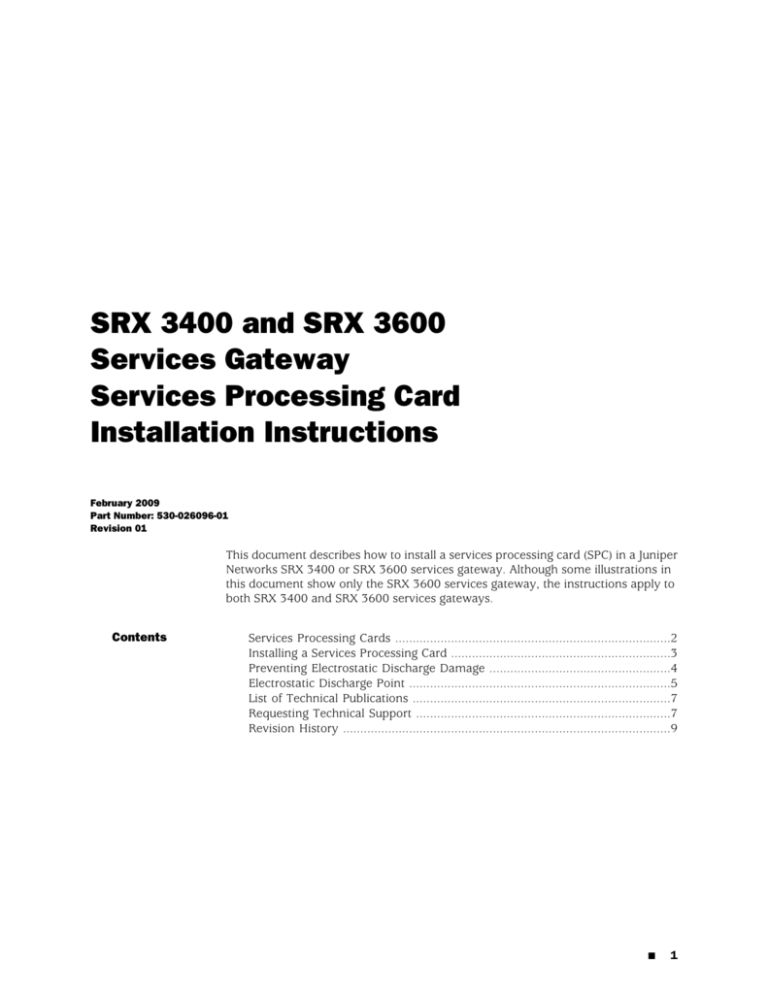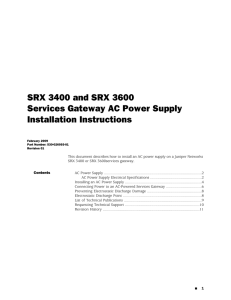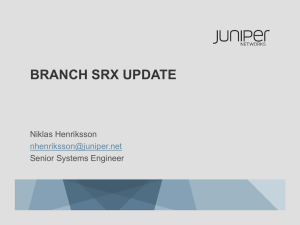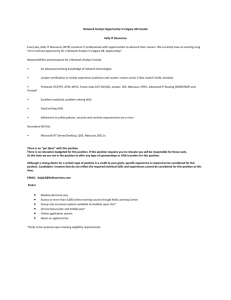
SRX 3400 and SRX 3600
Services Gateway
Services Processing Card
Installation Instructions
February 2009
Part Number: 530-026096-01
Revision 01
This document describes how to install a services processing card (SPC) in a Juniper
Networks SRX 3400 or SRX 3600 services gateway. Although some illustrations in
this document show only the SRX 3600 services gateway, the instructions apply to
both SRX 3400 and SRX 3600 services gateways.
Contents
Services Processing Cards ...............................................................................2
Installing a Services Processing Card ...............................................................3
Preventing Electrostatic Discharge Damage ....................................................4
Electrostatic Discharge Point ...........................................................................5
List of Technical Publications ..........................................................................7
Requesting Technical Support .........................................................................7
Revision History ..............................................................................................9
■
1
SRX 3400 and SRX 3600 Services Gateway Services Processing Card Installation Instructions
Services Processing Cards
Services Processing Cards (SPCs) are common form-factor module (CFM) cards that
provide the processing power to run integrated services such as firewall, IPsec and
IDP. All traffic traversing the services gateway is passed to an SPC to have service
processing applied to it. Traffic is intelligently distributed by Network Processing
Cards (NPCs) to SPCs for service processing, including session setup based on policies,
fast packet processing for packets that match a session, encryption and decryption,
and IKE negotation.
The services gateway must have at least one SPC installed. You may install additional
SPCs to increase services processing throughput. You can install SPCs in any CFM
slot, but we recommend that you install SPCs in rear panel slots to leave room for
IOCs in the front panel slots.
NOTE: If a CFM slot is not occupied by a card, you must install a blank panel to shield
the empty slot and to allow cooling air to circulate properly through the device.
Figure 1: Services Processing Card
SRX3K-SPC
g036032
-1-10-40
Table 1 on page 2 describes the SPC behavior indicated by the LEDs on its front
panel. To power up or power down an SPC, you must use the main Power button
on the front of the Switch Fabric Board (SFB). The ONLINE button does not perform
any function.
Table 1: Services Processing Card LED Indictors
2
Label
Color
Status
Indicated Behavior
SERVICE
Green
On steadily
The SPC is running under acceptable load.
Amber
On steadily
The SPC is overloaded.
Red
On steadily
No service is being provided by the SPC.
Dark (unlit)
Off
The SPC is not enabled.
■
Services Processing Cards
Installing a Services Processing Card
Table 1: Services Processing Card LED Indictors (continued)
Label
Color
Status
Indicated Behavior
OK/FAIL
Green
On steadily
The SPC is operating normally.
Green
Blinking
The SPC is preparing for hot-swap event.
Red
On steadily
The SPC has failed and is not operating normally.
Dark (unlit)
Off
The SPC is powered down.
Installing a Services Processing Card
The SRX 3400 and SRX 3600 services gateway supports up to 7 Services Processing
Cards (SPCs). You can install SPCs in any CFM slot, but we recommend that you
install SPCs in rear panel slots to leave room for IOCs in the front panel slots.
NOTE: If a slot is not occupied by a card, you must install a blank panel must to
shield the empty slot and to allow cooling air to circulate properly through the device.
To install an SPC:
1.
Attach an electrostatic discharge (ESD) grounding strap to your bare wrist and
connect the strap to one of the ESD points on the chassis. For more information
about ESD, see “Preventing Electrostatic Discharge Damage” on page 4.
2.
If you have not already done so, power off the device by pressing the Power
button on the front panel of the Switch Fabric Board (SFB) for three to five
seconds.
The PWR LED blinks to show you that the device is shutting down. Wait for the
device to shut down before proceeding.
3.
Place the card on an antistatic mat or remove it from its electrostatic bag.
4.
Identify the slot on the services gateway where you will install the SPC.
5.
Orient the SPC so that the faceplate faces you. Slide the SPC all the way into the
card cage until you feel resistance. See Figure 2 on page 4.
6.
Tighten the screws on either side of the card.
Installing a Services Processing Card
■
3
SRX 3400 and SRX 3600 Services Gateway Services Processing Card Installation Instructions
SRX3K-SPC-1
-10-40
7.
g036056
Figure 2: Installing an SPC (SRX 3600 shown, SRX 3400 Similar
If you plan to install any additional SPCs, repeat steps 3 through 6.
WARNING: Never lift the services gateway using the handles on the front panels of
the SPCs or other CFM cards. The handles might come off, causing the chassis to
drop and inflicting possible grave injury.
Preventing Electrostatic Discharge Damage
Many services gateway hardware components are sensitive to damage from static
electricity. Some components can be impaired by voltages as low as 30 V. You can
easily generate potentially damaging static voltages whenever you handle plastic or
foam packing material or if you move components across plastic or carpets. Observe
the following guidelines to minimize the potential for electrostatic discharge (ESD)
damage, which can cause intermittent or complete component failures:
■
Always use an ESD wrist strap or ankle strap, and verify that it is in direct contact
with your skin.
CAUTION: For safety, periodically check the resistance value of the ESD strap. The
measurement should be in the range of 1 to 10 Mohms.
4
■
■
When handling any component that is removed from the chassis, verify that the
equipment end of your ESD strap is attached to one of the ESD points on the
chassis, which are shown in Figure 4 on page 5, Figure 5 on page 6,
Figure 6 on page 6, and Figure 7 on page 7.
■
Avoid contact between the component and your clothing. ESD voltages emitted
from clothing can still damage components.
■
When removing or installing a component, always place it component-side up
on an antistatic surface, in an antistatic card rack, or in an electrostatic bag (see
Preventing Electrostatic Discharge Damage
Electrostatic Discharge Point
Figure 3 on page 5). If you are returning a component, place it in an electrostatic
bag before packing it.
Figure 3: Placing a Component into an Electrostatic Bag
Electrostatic Discharge Point
Figure 4 on page 5 and Figure 5 on page 6 show the location of the ESD points
on the SRX 3400 chassis. Figure 6 on page 6 and Figure 7 on page 7 show the
location of the ESD points on the SRX 3600 chassis.
Figure 4: Front View of the SRX 3400 Chassis
USB
ports
SFB
g036000
Console
ports
Slot
number ESD IOC in
point slot 1
guide
CFM slots
for IOCs
and SPCs
Cooling
air exhaust
Electrostatic Discharge Point
■
5
SRX 3400 and SRX 3600 Services Gateway Services Processing Card Installation Instructions
Figure 5: Rear View of the SRX 3400 Chassis
CFM slots
for SPCs
and NPCs
g036001
Routing
Engine
Chassis
grounding
point
Cooling
air inlets
Power
supplies
ESD
point
Slot
number
guide
Fan tray
door
Figure 6: Front View of the SRX 3600 Chassis
USB
ports
SFB
g036035
Console
ports
Slot
number
guide
6
■
Electrostatic Discharge Point
ESD
point
IOC in
slot 1
CFM slots
for IOCs
and SPCs
Cooling
air exhaust
List of Technical Publications
Figure 7: Rear View of the SRX 3600 Chassis
ESD
point
Power
supplies
Chassis
grounding
point
g036036
CFM
slots for
SPCs
Routing
Engine
CFM slots
for NPCs
and SPCs
Cooling
air inlets
Fan tray
door
Slot
number
guide
List of Technical Publications
Table 2 on page 7 lists the hardware guides and release notes for Juniper Networks
SRX-series services gateways and describes the contents of each document. All
documents are available at http://www.juniper.net/techpubs/.
Table 2: Technical Documentation for Supported Devices
Book
Description
Hardware Documentation
SRX 3400 Services Gateway Hardware Guide or
SRX 3600 Services Gateway Hardware Guide
Describes how to install, maintain, and troubleshoot the services
gateway and components. Each services gateway type has its own
hardware guide.
Release Notes
JUNOS Software for SRX-series Services Gateway
Release Notes
Summarizes new features and known problems for a particular
release of JUNOS software on SRX-series services gateways,
including J-Web interface features and problems. The release notes
also contain corrections and updates to the manuals and software
upgrade and downgrade procedures.
Requesting Technical Support
Technical product support is available through the Juniper Networks Technical
Assistance Center (JTAC). If you are a customer with an active J-Care or JNASC support
contract, or are covered under warranty, and need postsales technical support, you
can access our tools and resources online or open a case with JTAC.
List of Technical Publications
■
7
SRX 3400 and SRX 3600 Services Gateway Services Processing Card Installation Instructions
■
JTAC policies—For a complete understanding of our JTAC procedures and policies,
review the JTAC User Guide located at
http://www.juniper.net/customers/support/downloads/710059.pdf.
■
Product warranties—For product warranty information, visit
http://www.juniper.net/support/warranty/.
■
JTAC Hours of Operation —The JTAC centers have resources available 24 hours
a day, 7 days a week, 365 days a year.
Self-Help Online Tools and Resources
For quick and easy problem resolution, Juniper Networks has designed an online
self-service portal called the Customer Support Center (CSC) that provides you with
the following features:
■
Find CSC offerings: http://www.juniper.net/customers/support/
■
Search for known bugs: http://www2.juniper.net/kb/
■
Find product documentation: http://www.juniper.net/techpubs/
■
Find solutions and answer questions using our Knowledge Base:
http://kb.juniper.net/
■
Download the latest versions of software and review release notes:
http://www.juniper.net/customers/csc/software/
■
Search technical bulletins for relevant hardware and software notifications:
https://www.juniper.net/alerts/
■
Join and participate in the Juniper Networks Community Forum:
http://www.juniper.net/company/communities/
■
Open a case online in the CSC Case Management tool: http://www.juniper.net/cm/
To verify service entitlement by product serial number, use our Serial Number
Entitlement (SNE) Tool located at https://tools.juniper.net/SerialNumberEntitlementSearch/.
Opening a Case with JTAC
You can open a case with JTAC on the Web or by telephone.
■
Use the Case Management tool in the CSC at http://www.juniper.net/cm/ .
■
Call 1-888-314-JTAC (1-888-314-5822 toll-free in the USA, Canada, and Mexico).
For international or direct-dial options in countries without toll-free numbers, visit
us at http://www.juniper.net/support/requesting-support.html.
8
■
Requesting Technical Support
Requesting Technical Support
Revision History
February 2009—530-026096-01. Revision 01 Initial Release.
Copyright © 2009, Juniper Networks, Inc. All rights reserved.
Juniper Networks, the Juniper Networks logo, JUNOS, NetScreen, ScreenOS, and Steel-Belted Radius are registered trademarks of Juniper Networks, Inc. in
the United States and other countries. JUNOSe is a trademark of Juniper Networks, Inc. All other trademarks, service marks, registered trademarks, or
registered service marks are the property of their respective owners.
Juniper Networks assumes no responsibility for any inaccuracies in this document. Juniper Networks reserves the right to change, modify, transfer, or
otherwise revise this publication without notice.
Products made or sold by Juniper Networks or components thereof might be covered by one or more of the following patents that are owned by or licensed
to Juniper Networks: U.S. Patent Nos. 5,473,599, 5,905,725, 5,909,440, 6,192,051, 6,333,650, 6,359,479, 6,406,312, 6,429,706, 6,459,579, 6,493,347,
6,538,518, 6,538,899, 6,552,918, 6,567,902, 6,578,186, and 6,590,785.
Requesting Technical Support
■
9










